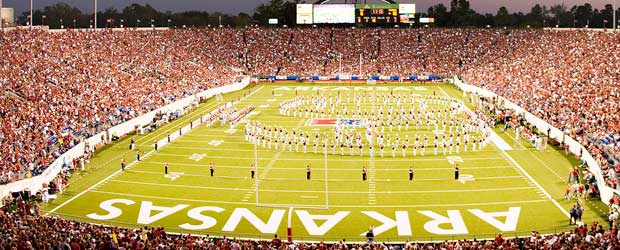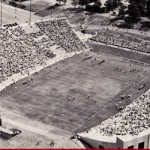 My wife constantly reminds me that I get involved in too many crusades.
My wife constantly reminds me that I get involved in too many crusades.
There are worse things in life, I suppose, than having multiple passions.
And I was passionate about trying to save Ray Winder Field, which was one of the 10 oldest professional baseball parks in America. I knew that if the Arkansas Travelers were to retain their big league affiliation, they had to move out of the crowded old park in the middle of Little Rock. But it could have — should have — been saved for amateur baseball.
Some of us tried.
We lined up high school, college and American Legion teams to play there. We formed a nonprofit organization to operate the ballpark.
But the city of Little Rock barely gave us the time of day. Our “city leaders” sold the iconic Arkansas structure to the University of Arkansas for Medical Sciences to turn into a parking lot.
To this day, I can’t bear to look when driving down Interstate 630.
Jay Jennings, a Little Rock-based writer and editor who once was a reporter for Sports Illustrated, put it this way in a beautifully written essay for Arkansas Life magazine back in 2012: “Ray Winder Field is now flattened, no mound in its middle, its concrete rubble hauled away, its fences knocked down, its I-beams only a ghostly memory. I mourn its demise and can conjure up my youthful summer nights there, chasing down foul balls through empty rows of seats, rushing to the dugout fence to ask for a broken bat, reveling in the varying textures of a Drumstick ice cream cone. Baseball has always been about nostalgia and fungible time.
“Maybe it’s the absence of Ray Winder Field that is causing me to think about its bigger, younger sibling just down the road, its seeming opposite: War Memorial Stadium. Even the names are a contrast: One the home of bucolic and breezy summer languidness (rays, wind, a field), the other evoking martial battles, death and enormity. A field is where games are played; a stadium is where crowds assemble.
“But there’s something about War Memorial that’s also worthy of nostalgic reflection, of civic affection. As a child (too young or too unruly for my parents to consider taking me to a game), on fall Saturdays, I would take my radio out on the front porch to listen to the game, and though I was more than two miles away, I could hear the roar from the crowd not only through my radio but from the stadium itself. But more than gratuitous self-reflection led me to consider War Memorial anew. Since it hosts Razorback games, high school football games (preseason, Catholic High and state championships), University of Arkansas at Pine Bluff games, band competitions, concerts and various other events, it’s possible that War Memorial Stadium is the most visited site in the state.”
In all of the statewide debate in recent years as to whether the University of Arkansas should continue playing football games in the capital city, one thing has been forgotten: War Memorial Stadium is one of this state’s top public works projects and also its largest memorial to the veterans of World War I and World War II.
It deserves to be preserved and treasured as we hopefully atone for the sin of allowing Ray Winder Field to be demolished — for a parking lot, for gosh sakes.
On Sept. 18, 1948, the University of Arkansas brought its football team to Little Rock to play Abilene Christian at the new stadium. Maurice “Footsie” Britt, who would be elected lieutenant governor 18 years later, led the dedication ceremonies.
Britt was the first person to earn all of the U.S. Army’s top awards, including the Medal of Honor, while fighting in a single war. Born in 1919 at Carlisle, Britt later moved to Lonoke and became a high school sports star. Because he wore size 13 shoes, he became known as “Footsie.” Britt was the captain of the football, basketball and track teams at Lonoke. He also was elected class president and was the valedictorian of his senior class.
Following his graduation in June 1937, Britt received an athletic scholarship to Arkansas, where he played football and basketball for the Razorbacks in addition to serving as the sports editor of the student newspaper.
After college, Britt signed a contract to play professional football for the Detroit Lions. His professional career was cut short when he joined the Army at the outset of World War II. He received the Medal of Honor for his gallantry in a battle near Mignano, Italy, on Nov. 10, 1943.
On Feb. 12, 1944, Britt lost his right arm when an artillery shell landed near him.
War Memorial Stadium was built to honor Arkansans such as “Footsie” Britt.
We forget that, don’t we?
Gov. Asa Hutchinson’s announcement at the state Capitol last month was significant. Hutchinson proposed that the stadium become a part of the state Department of Parks & Tourism, a move that could at last take the spotlight off the issue of Razorback games and put it back where it should be — the protection of an Arkansas shrine.
The War Memorial Stadium Commission — under the leadership of Little Rock attorney Kevin Crass and his predecessor as chairman, Little Rock businessman Gary Smith — has done an outstanding job updating the facility since the turn of the century.
The stadium that Britt helped dedicate in 1948 had 31,000 seats. A major expansion project occurred in 1967 as interest in Razorback football reached a fever pitch following the 22-game winning streak in 1964-65. The stadium now holds almost 54,000 people.
In the past 15 years, virtually every area of the stadium has been updated — new lights, new artificial turf, a restoration of the outside of the structure, new scoreboards and video boards.
In 2010, the commission completed a $7.3 million project that included a three-story press box and additional club seats.
If there’s an area in which the commission has fallen short, it’s probably in properly informing Arkansans about those improvements. Each time the debate about Razorback games in Little Rock rages, uneducated Hog fans and message board trolls post comments on social media that paint the picture of an aging, municipal-owned stadium (think Legion Field in Birmingham) that has been allowed to deteriorate.
The truth is that it’s a state-owned facility that looks better than it ever has.
“Maybe the state doesn’t completely understand that 250 days out of the year, we have one or more events that are at War Memorial Stadium,” says Jerry Cohen, the stadium manager. “We’re an event center as well as a football stadium. We look at this as a chance for growth. … There are only two bathrooms and a kitchen that haven’t been redone. We’re basically a new structure other than the concrete and the bleachers.”
Regardless of whether the University of Arkansas continues playing games at War Memorial Stadium past 2018 or not, this is a story that could have a happy ending for the stadium. With the inherent strengths of the Department of Parks & Tourism — think sports and veterans’ exhibits around the concourse, a gift shop, a small theater, maybe even a restaurant — some of the beloved memorial’s best days could be ahead.
“War Memorial Stadium is a critical part of our lifeblood,” Hutchinson says.
Jennings wrote in the 2012 magazine story: “I usually park for free on Kavanaugh’s commercial strip in Hillcrest and walk past modest houses to Markham, where the stadium suddenly rises in front of me. It’s a neighborhood stadium. That charm may be one reason the Bleacher Report website named War Memorial one of the top 50 stadiums in college football last year. … She’s an old lady who has aged well. Look closely at the architecture, which you may never have done before.
“The main facade’s portal is a lovely piece of postwar simplicity, an example of a trend that one contemporary critic has described as ‘the postwar revolt against the stylistic clutter of traditional moldings and ornamentation.’ Over an aluminum canopy covering the entrance are three large windows made of translucent glass bricks (as are all of the external windows in the stadium), and these in turn are covered by an aluminum grill of six long horizontal bars and six shorter vertical bars, similar to what you might see on the front of cars of that vintage.
“The architects, Burks and Anderson, were liberal in their use of aluminum because at the time, Arkansas produced more of it than any other state in the country, and they wanted to showcase Arkansas materials. Above the grilled windows are three enormous aluminum plaques depicting football players in stylized action poses. I don’t know who the artist is, but they’re quite striking. … Above them is a terrific mid-century-modern sans-serif font spelling out War Memorial Stadium. All of these elements speak of a thoughtful and sensitive public building.”
The director of the state Department of Parks & Tourism, Kane Webb, is a former sports reporter like Jennings and also a fan of the stadium.
“I love War Memorial Stadium,” Webb says. “I saw my first college football game there in 1972. My dad took me to see Joe Ferguson and the Hogs. Unfortunately, they lost to Rice that day, but he gave me a souvenir on the way home to make me feel better. I played there at Catholic High for the Rockets. I covered dozens of high school and college games there as a sportswriter. Now on Friday night, when the Rockets are home, I’m out there watching my daughter perform as a Mount St. Mary Rockette. It means a lot to me.”
Members of the commission overseeing Webb’s department seem excited about the opportunity to have a flagship facility in the middle of the state’s largest city. They already operate 52 state parks, and Arkansas’ parks system is recognized as being among the best of the country.
Envision this:
Continue reading here…













